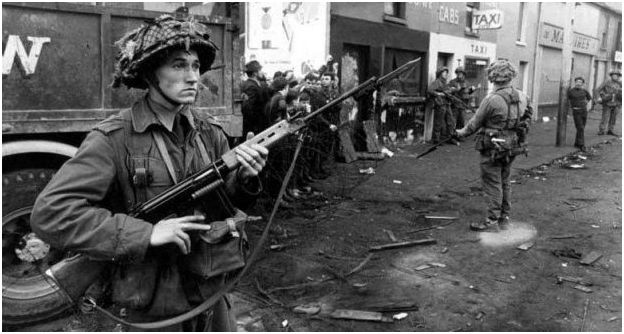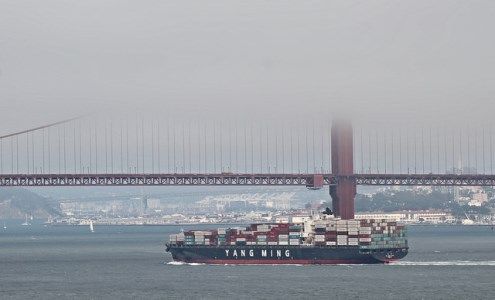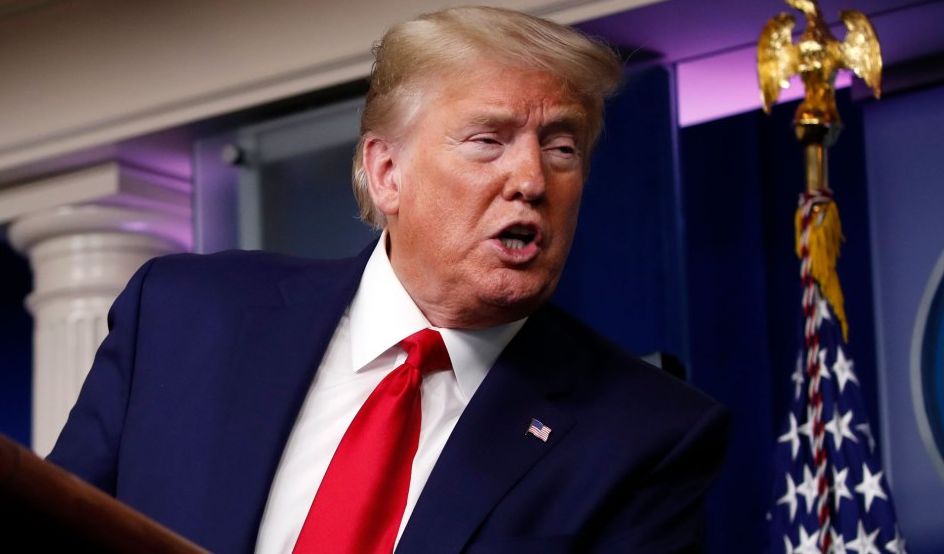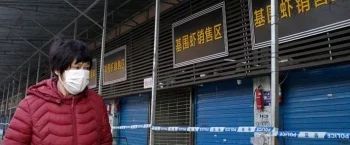Peter Hadden is a member of the Socialist Party (CWI in Ireland).

August 1969 was a turning point in the history of Northern Ireland. It was then that the Labour Government of Harold Wilson took the decision to send troops onto the streets, first of Derry, then of Belfast.
The measure was presented as temporary – troops were needed, they said, because, with riots sweeping the streets, with huge parts of Derry and Belfast sealed off behind barricades and with pogroms starting to develop, it was clear that the Unionist government at Stormont had lost control. It was to be a “stop gap.” The troops would be withdrawn “as soon as law and order is restored.”
As in Iraq and Afghanistan, the British ruling class were to discover that it is one thing to send their army into a conflict, it is a different matter entirely to get them out. In the case of Northern Ireland the “temporary” deployment turned into twenty five years of bloody conflict, with the troops in the front line, followed by a decade and a half of uneasy peace, with the troops in barracks, only a brief mobilisation away from a return to the streets.
August ’69 was a turning point because it drew a line under the opening, civil rights phase of the Troubles and laid the basis for the emergence of new political and paramilitary forces that would dominate for decades to come.
The Troubles had begun in earnest ten months earlier with an explosion of anger in Catholic working class communities at the injustices meted out to them by the then Unionist State. For almost fifty years, since the founding of the state, Catholics had suffered systematic discrimination in housing and in jobs. Catholics were also partly disenfranchised by the blatant gerrymandering of electoral boundaries.
On 5 October a small demonstration in Derry made up mainly of members of left wing organisations, notably members of Derry Labour Party and Derry Young Socialists, demanding an end to discrimination and jobs and houses for all, was banned and then met with the full fury of baton waving members of the Royal Ulster Constabulary (RUC). The images of police savagely beating peaceful demonstrators ignited anger in working class communities and the Civil Rights Movement was instantly transformed from a quite small scale affair into a mass movement of the Catholic working class.
Among the youth who poured onto the streets, rage at the Unionist establishment was coupled with contempt for the nationalist politicians who had delivered nothing for the Catholic community. In opposing and confronting unionist misrule, this movement, in the process, shook off the fossilised ideas of right wing nationalism. Socialist ideas began to develop a real echo, especially in Derry where the radicalised local Labour Party was able to articulate the anger of young people at slum housing and mass unemployment.
Housing conditions in Protestant working class areas were no different from those in Catholic areas. The problem was not just discrimination but the almost complete absence of a public authority house building program.
Similarly in relation to jobs. Although discrimination put Protestants first in line for some jobs, poverty and unemployment likewise blighted Protestant working class areas.
A missed chance for unity
Had 5 October ignited, as was possible, a struggle not just against discrimination – including the discrimination by Nationalist councils against Protestants – but also for decent houses and jobs for all, a powerful and united movement of the working class could have emerged.
Forty years of the Troubles later it hardly needs to be said that this did not happen. It did not happen because of the absence of any leadership equipped with the will, the ideas and also the authority to bring it about. The trade union leadership, heading a 210,000 strong movement, sat aloof from the turmoil that followed 5 October. They sat aloof through the months of demonstrations, counter demonstrations, riots and mounting tension, restricting themselves to praising the Unionist government for the partial reforms that were forced on them and to issuing sanctimonious pleas for calm.
In Derry the recently established Labour Party branch shifted rapidly to the left during these events. While perhaps not to the same extent, a similar process was underway in other sections of the Northern Ireland Labour Party (NILP) which, at this time had a growing base in working class communities, Catholic and Protestant.
A motion to the NILP Conference in May 1969 called on the party to attempt to take a leadership role in the Civil Rights struggle. The right wing leadership, cautious about opposing it openly, tried to get it remitted – but the Conference overruled them and the motion was passed. It made little difference as the leadership simply ignored it and imitated their union counterparts in doing nothing.
The failure of the labour movement to intervene assisted the so-called civil rights moderates – people like future Social Democratic and Labour Party (SDLP) leader, John Hume – to stamp their authority on the Civil Rights Movement. Hume, who was a voice for the conservative Catholic middle class, argued vehemently against class or socialist ideas that might “split” the all class unity that was being built.
There would have been a reaction from die hard unionists and from the most backward sections of the Protestant population to the civil rights struggle no matter what. But limiting the program of the Civil Rights movement only to rights for Catholics allowed the government – as well as demagogic figures like Ian Paisley – to paint this as a movement against Protestants and to gain a wider base for their poisonous and reactionary ideas.
There was a strong left within the civil rights movement. Influential figures like Eamonn McCann, then of Derry Labour Party, and Bernadette Devlin, who defeated a Unionist to take the Mid Ulster Westminster seat, sprang to prominence. The radicalisation that swept Catholic areas allowed Peoples Democracy – a loose formation formed by Queens University students – to gain a certain base of support among Catholic working class youth.
But mass revolutionary upheaval is a stern test for socialists – especially in a complex situation like that in Northern Ireland. The groups that did develop were handicapped by confusion, ultra leftism and a fatal tendency to buckle politically under pressure. Eamonn McCann, for example, at first went along with John Hume’s call for a ban on placards, banners, slogans or any alternative message from civil rights platforms.
Escalating sectarian tensions
By 1969, as a backlash to the marches set in, events had begun to take on a sharper edge. In the months leading up to August there was serious rioting in Derry, Dungiven, Armagh, Lurgan and other area. Ominously by July the trouble had spread to parts of Belfast with riots and bitter sectarian clashes. In the tense atmosphere that was developing the initial civil rights demands receded and it was the issue of defence – defence against attack by sectarians and by the police – that was now to the fore.
The paramilitary organisations that were soon to put themselves forward as the “defenders” of working class communities to all intents and purposes did not exist at this time.
A Shankill Defence Association that had been formed out of rioting in the area was a forerunner of the organisations that two years on would come together as the UDA, but it was the only one of its kind. The UVF had tried to reform in the mid 1960s but had more or less fallen to pieces as a result of a combination of state repression and disinterest on the part of the Protestant community. A section of the unionist establishment – people from within the Cabinet and not so much from the Paisleyite fringe as is commonly assumed – were trying to encourage its reformation but this amounted to very little at this time.
The IRA was a spent force, not recovered from the failure of its ‘border campaign’ of the 1950s and virtually disarmed. According to one account (Bishop/Mallie, The Provisional IRA), at a meeting of the IRA command in Dublin in May 1969 when future Provisional leader, Ruairi O’Bradaigh raised the issue of defence he was told by the then OC and future Official IRA leader, Cathal Goulding that “it was up to the official forces of the British Army and RUC to defend the people.” When asked what weapons might be available Goulding’s response was: “a pistol, a machine gun and some ammunition.” This is almost certainly a Provisional embellishment of the truth but it is not that far from an accurate assessment of the IRA’s capacity at the time.
As the clock ticked down to the annual Apprentice Boys parade which would see 15,000 Protestants march past the Bogside in Derry the atmosphere in the North became ever more tense. The threat of serious sectarian clashes that could spread to other towns and to Belfast was obvious. In Derry the timid Citizens Action Committee was defunct. A few republicans, along with some other individuals, had responded to earlier attacks on the Bogside by setting up a Derry Citizens Defence Association. In parts of Belfast local vigilante and defence groups were springing up. In the main these were not the sectarian bodies that were later to develop. In many mixed communities local defence groups involving Catholics and Protestants were set up to keep the trouble out of their area.
The trade union leaders, rather than take an initiative to co-ordinate these groups into a force that could resist sectarianism in all its forms, continued with their heads in the sand approach. Their only intervention was a statement issued on 4 August – just over a week before the Apprentice Boys march – asking trade unionists to “avoid street meetings and gatherings likely to lead to community troubles.”
There was confusion too among the prominent left leaders who had emerged from the civil rights struggle. Lacking the steadying influence of a revolutionary party, even the best leaders – Bernadette Devlin and Eamonn McCann included – vacillated under the pressure. Rather than maintain an independent class position, Bernadette Devlin flew to America where she pleaded with UN Secretary General U Thant for UN troops to be sent in. When fighting started in the Bogside she and Eamonn McCann issued a joint statement headed “Westminster must act” calling for the suspension of the northern constitution and a constitutional conference of the Westminster, Stormont and Dublin governments to work out a solution.
Battle of the Bogside
The Apprentice Boys parade on 12 August started peacefully enough but that didn’t last long. Derry Labour Party and Young Socialist members were on the streets trying to stop young people from the Bogside from attacking the marchers. It worked for a while but eventually the inevitable happened. Stones were thrown at the parade, fighting followed and the RUC responded by launching a full scale assault on the Bogside.
As soon as that happened the Labour Party and Young Socialist members who had been advocating restraint joined with the rest of the people of the area who responded almost to a person by raising barricades and resisting the RUC with stones and then with petrol bombs.
The Battle of the Bogside raged for more than two days. The RUC repeatedly charged the crowds defending the area but were just as repeatedly driven back by a fusillade of stones and petrol bombs, some rained down on their heads from the people who had taken up a position on top of the high rise Rossville Flats. People in other Catholic communities took to the streets in a deliberate attempt to stretch the RUC.
One day into the battle a statement issued by the Irish government raised the sectarian temperature. People in the south, horrified at the scenes they were witnessing on their TV screens, were demanding that something be done. Irish Taoiseach, Jack Lynch, said that his government “would not stand idly by”. Irish military field hospitals were to be set up across the border from Derry in Donegal. Lynch’s bluster was no more than a cover for the fact that the Irish government were “going to stand idly by” – but that’s not how Protestants in the north saw it and the effect was to stir the already aroused sectarian tensions.
The RUC, the force the Unionist Government was relying on to maintain its grip, was 3,200 strong. After months of rioting 600 RUC officers were out injured even before the Bogside erupted. Two days into the August battle and this ill equipped, ill trained force was all but defeated. The Unionist’s answer was to issue an order calling up the 8,500 strong police reserve, the notorious B Specials.
The troops go in
Had this armed and bigoted Protestant militia been sent against the Bogside there almost certainly have been a bloodbath. The violence would have spread and a civil war that would have engulfed Ireland, north and south, would have been the most likely outcome. It was to avert this possibility that the Wilson Government decided to deploy troops.
It was not that the British ruling class had any particular concern for the beleaguered Catholic population of the Bogside. But a civil war in Ireland would spark upheaval in major British cities. It would engulf their property in Ireland and would leave the trade and other economic relations they were carefully nurturing with Dublin in shreds. Moreover it would lead to a wave of anti British sentiment in the US and in other key countries.
As soon as it was clear that the troops were not going to force their way into the Bogside there was a sense of massive relief that expressed itself in a warm welcome for the soldiers.
But no sooner had an uneasy calm returned to Derry when parts of Belfast erupted into much more bloody and sectarian upheaval. Intense fighting took place in the streets linking the Lower Falls and Shankill and between the Shankill and Ardoyne.
Streets were invaded by huge crowds, some of them armed.The RUC blazed their way into the Falls firing machine guns mounted on Shoreland armoured cars. By the morning seven people were dead, five Catholic and two Protestant, 750 were injured, whole streets were ablaze, and refugees were picking their way through the barricades and rubble to flee.
That afternoon 600 steel helmeted troops arrived, bayonets fixed, and nervously took up positions in the area. They had little or no idea of the local geography and even less idea of which way they should point their rifles if fighting re-erupted. Riots continued that night in other areas but, by the weekend, an even more uneasy calm than existed in Derry was restored.
At this point 150,000 people were living behind barricades in Catholic areas where the writ of the State no longer ran. The attitude of these people to the troops was generally welcoming at first. They saw the troops as having lifted the siege of their areas. Politicians across the board, including the main Civil Rights leaders all joined the welcome.
So did most of the left in Britain and Ireland. The very individuals and groups who a few years later were to be the most vociferous in demanding “troops out now” supported the decision to send them in.
Just hours before the soldiers arrived in Derry, Bernadette Devlin had been on the phone from behind the barricades pleading with Home Secretary, James Callaghan, that they be sent.
The Socialist Workers Party criticised those who called for the troops to be withdrawn. This is what they said at the time:
“The breathing space provided by the presence of British troops is short but vital. Those who call for the immediate withdrawal of the troops before the men behind the barricades can defend themselves are inviting a pogrom which will hit first and hardest at socialists.” (Socialist Worker, No. 137, 11 September 1969)
Militant – the CWI in Britain – was alone on the left in taking a clear class position. Then a four page black and white monthly, the headline of the September 1969 issue of Militant demanded the withdrawal of the troops. It called instead for an armed trade union defence force. An article analysing the situation warned: “The call made for the entry of British troops will turn to vinegar in the mouths of some of the civil rights leaders. The troops have been sent to impose a solution in the interests of British and Ulster big business.”
This was no abstract position conjured from the safety of distance. The few members and supporters of Militant in Northern Ireland at the time were behind the Derry barricades, involved in the defence of the area and facing the consequences of any pogrom. Unlike the SWP and others, Militant did not bend to what was a temporary mood of support for the troops but explained the real reasons they had been sent and warned what their role would be. This position has been absolutely vindicated by what followed.
The basis for working class defence forces
Nor was the call for a trade union defence force an abstract slogan, removed from the reality of the time. The truth is the troops did not and could not have prevented widespread pogroms. Their presence had a psychological rather than a physical impact and, in this sense, it did help produce a temporary calm.
But the army presence was only in Derry and a small part of Belfast. Elsewhere it was the actions of working class people that prevented the trouble spreading. In the Docks, Grosvenor Road, East Belfast, Alliance Avenue and many other areas people took to the streets and physically stopped the violence and intimidation. In the Carlisle flats, close to the Shankill, Catholic residents who had fled were returned to their homes by local residents.
Shop stewards in the big factories and workplaces meanwhile acted to halt sectarian intimidation. Shipyard shop stewards called a mass meeting attended by virtually the entire workforce and called a brief token strike opposing conflict. Shop stewards followed this by visiting the homes of Catholic shipyard workers who had stayed away from work and assured them of their safety if they returned.
Had these initiatives not been taken, and had the violence spread, the army would have been powerless to prevent widespread pogroms and even civil war. All they could have done – as was subsequently admitted – would have been to set up secure corridors to evacuate people to safer areas. It was the instinctive actions of working class people that prevented a slide to civil war.
The outlines of a workers’ defence force already existed. Had the trade union leadership been prepared to give a lead – or had their been a revolutionary organisation with sufficient support in workplaces and working class communities – it would have been possible to bring together shop stewards committees and the various anti sectarian defence organisations that had sprung up. Links could have been established with the expanded Defence Committees that now controlled the barricaded areas of West Belfast and Derry.
Rather than any such initiative the union leadership went into an even closer huddle with the Unionist Government. They met with Stormont Ministers in early September and issued a joint statement applauding the paltry reforms that had been announced, appealing for people to stay off the streets and for the barricades to come down. It was a kick in the teeth for the thousands of trade union members who had taken to the streets to defend their areas and to stop sectarian intimidation.
The rise of sectarian militias
Not for the first time – or the last – the failure of the labour movement cleared the way for other forces to emerge. The seeds of the Provisional IRA were sown by the inability of the old guard leadership of the IRA to offer any defence of Catholic communities in August. While Bombay Street and other parts of the Lower Falls burned, the total strength that the IRA could muster was a few veteran republicans who took up positions in a local school armed with a Thompson sub machine gun, a 303 rifle and four pistols and who opened fire on the approaching Protestant crowds.
As “IRA – I Ran Away” graffiti went up in the area, disgruntled republicans met and began to organise the split that a few months later would lead to the formation of the Provisional IRA.
It was not long either before the true role of the troops began to be seen. Ironically it was Protestants on the Shankill Road who were given the first taste of the brutal methods that would soon become commonplace. An announcement made in October that the B Specials were to be disbanded and replaced by a new force – the Ulster Defence Regiment (UDR) – was warmly greeted by civil rights leaders – and by both the NILP and the unions – but provoked outrage among Shankill Road Protestants.
Shots were fired during subsequent rioting in the area killing a policeman, the first RUC officer to be killed, again ironically at the hands of Protestants. The response of the State was to send in troops who dealt with the riots with particular ferocity. The army admitted to firing 66 rounds, killing one person. The next day they conducted an arms search, moving street by street through the area, ransacking homes as they went. One of the officers in charge, a Major Hitchcock, confessed to the press: “We are searching everything. I’m afraid we’re not being very polite about it.”
Civil Rights leaders – and some republicans and others prominent in the Central Citizens Defence Committee that had been set up linking the barricaded Catholic areas – applauded the army action. A few months later, in the summer of 1970, the shoe was on the other foot. Troops imposed a 34-hour curfew on the Lower Falls and began an arms search, using the same methods as they had on the Shankill. They met armed resistance from both wings of the IRA, the Officials as well as the Provisionals. At the end of it all five people were dead and sixty injured – but the biggest casualty, as far as the State was concerned, was the change in attitude towards the troops. The honeymoon they had enjoyed in Catholic areas since the previous August was over in that area at least.
Paddy Devlin, still an NILP MP for the area, recorded the change: “Overnight the population turned from neutral or even sympathetic support for the military to outright hatred of everything related to the security forces. As the self styled generals and godfathers took over in the face of this regime, Gerry Fitt and I witnessed voters and workers … turn against us to join the Provisionals.” Much worse was to come.
Those socialists who supported the decision to send in the troops should remember that the “armed bodies of men” of any capitalist State represent ultimately the interests of the ruling class, not of the working class. In Northern Ireland the troops provided repression, not security and their presence vastly complicated the situation. Forty years on we are left with a more divided society and a sectarian impasse that passes itself off as a “peace process”.
There is nothing inevitable about history. The forty years of conflict only became “inevitable” because of the absence of a leadership able to offer a socialist way out.
Today the key task is to build such a leadership so that the mistakes of the past are not repeated and that the new opportunity that is now opening for socialist ideas is not let slip.



